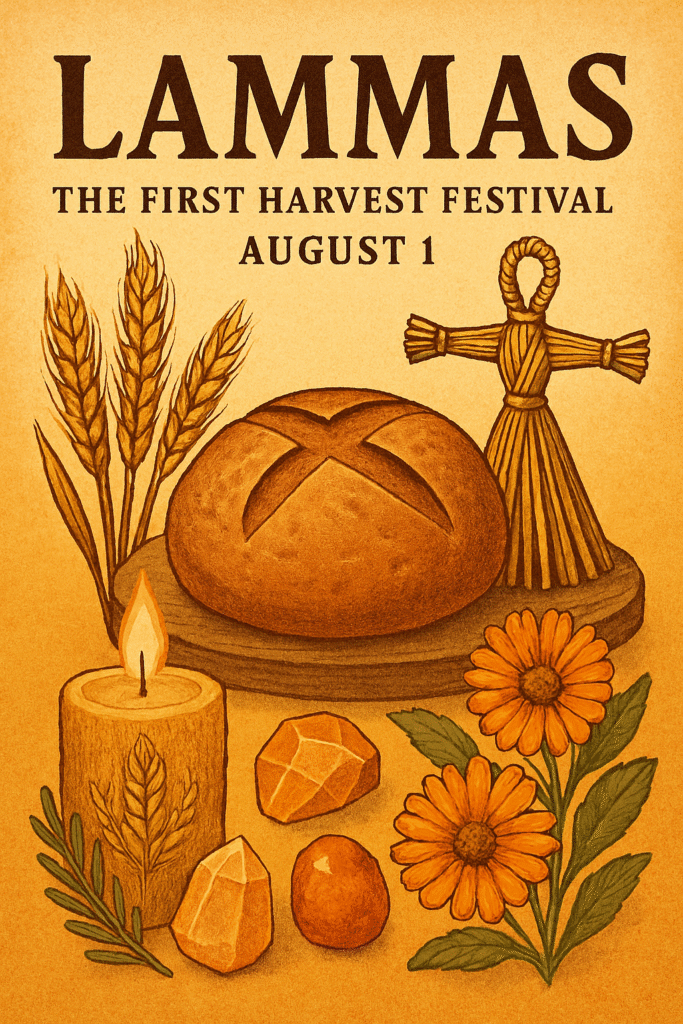
Lammas, also known as Lughnasadh, is a traditional Pagan festival celebrated on 1 August in the Northern Hemisphere. It marks the beginning of the harvest season, a time to honour the Earth’s abundance, reflect on sacrifice, and celebrate community through ritual and shared offerings.
Historical Origins
The term Lammas derives from the Old English hlaf-mas, meaning “loaf-mass”. This name reflects the ancient custom of baking a loaf of bread from the first grain harvest and offering it in thanks. Lammas was historically observed in agrarian societies where the early harvest of wheat, barley, and other grains was critical to survival. The festival symbolised both hope and anxiety—hope for a bountiful yield and fear of scarcity during the coming winter.
In Celtic tradition, the festival is also known as Lughnasadh, named after the god Lugh, a deity of light, craftsmanship, and skill. According to myth, Lugh established the festival to honour his foster mother Tailtiu, who died from exhaustion after clearing the plains of Ireland for agriculture. Thus, Lughnasadh commemorates both the harvest and the sacrifices made to sustain life.
Folklore and Symbolism
Lammas is steeped in folklore that emphasises the cyclical nature of life and death. The cutting of grain—once a living force—is symbolic of sacrifice and transformation. In Wiccan belief, this act represents the duality of life and death, reinforcing the sacred cycle of rebirth that governs nature.
Corn dollies, crafted from the first sheaves of grain, are a common folkloric tradition. These figures are often kept until the following spring and then ploughed into the fields to bless the next planting season. They embody the spirit of the harvest and serve as talismans of fertility and protection.
Rituals and Traditions
Lammas celebrations vary across Pagan paths but often include:
- Bread baking: A central ritual where loaves are baked from the first grain and offered in gratitude.
- Feasting: Communities gather to share seasonal foods, especially fruits, grains, and mead.
- Crafting corn dollies: Symbolic figures made from harvested stalks.
- Bonfires and dancing: Celebratory gatherings that honour the sun’s waning power.
- Offerings to deities: Particularly to Lugh or Earth goddesses, acknowledging their role in sustaining life.
Gifts and Seasonal Offerings
Gift-giving during Lammas reflects themes of abundance, gratitude, and craftsmanship. Popular items include:
- Handmade bread or baked goods: Symbolising the fruits of labour and shared sustenance.
- Harvest-themed candles: Infused with herbs like rosemary, sage, or wheat essence.
- Corn dollies and straw crafts: Representing fertility and protection.
- Crystals aligned with the season: Such as citrine, carnelian, and sunstone, which embody vitality and solar energy.
- Herbal bundles or oils: Featuring seasonal herbs like mugwort, chamomile, and calendula.
These gifts are often exchanged among coven members or given as offerings during rituals to honour the harvest and the sacrifices that made it possible.
Lammas is a festival of profound depth, blending agricultural history, mythic reverence, and spiritual reflection. It invites practitioners to honour the Earth’s bounty, acknowledge the cost of growth, and celebrate the enduring cycle of life.
